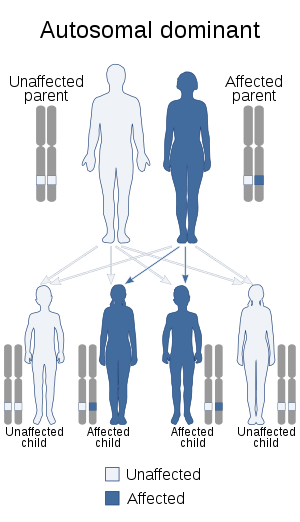Multicentric carpotarsal osteolysis syndrome
Multicentric carpotarsal osteolysis syndrome is a rare autosomal dominant condition.[2] This condition is also known as idiopathic multicentric osteolysis with nephropathy. It is characterised by carpal-tarsal destruction and kidney failure.
| Multicentric carpotarsal osteolysis syndrome | |
|---|---|
| Other names | MCTO[1] |
 | |
| This condition is inherited in an autosomal dominant manner. | |
| Specialty | Medical genetics |
Signs and symptoms
The presentation is of gradual loss of the small bones in the carpus and tarsus. This may lead to joint subluxation and instability.
The kidney failure, when present, usually presents as the presence of protein in the urine.
In some cases, there may also be craniofacial abnormalities including
- Triangular facies
- Micrognathia
- Maxillary hypoplasia
- Exophthalmos
Histology of renal biopsies show glomerulosclerosis and severe tubulointerstitial fibrosis.
Intellectual disability may occur.
Genetics
This condition is caused by mutations in the transcription factor MafB, or V-maf musculoaponeurotic fibrosarcoma oncogene homolog B (MAFB), gene.[3] This gene encodes a basic leucine zipper (bZIP) transcription factor.
The gene is located on the long arm of chromosome 20 (20q11.2-q13.1).
Pathogenesis
How this mutation causes the clinical picture is not currently clear.
Diagnosis
The diagnosis may be suspected on the basis of the constellation of clinical features. It is made by sequencing the MAFB gene.
Differential diagnosis
The condition should be differentially diagnosed from juvenile rheumatoid arthritis.
Classification
This condition has been classified into five types.[4]
- Type 1: hereditary multicentric osteolysis with dominant transmission
- Type 2: hereditary multicentric osteolysis with recessive transmission
- Type 3: nonhereditary multicentric osteolysis with nephropathy
- Type 4: Gorham–Stout syndrome
- Type 5: Winchester syndrome – defined as a monocentric disease with autosomal recessive inheritance
Treatment
Optimal treatment for this condition is unclear. Bisphosphonates and denosumab may be of use for the bone lesions. Cyclosporine A may be of use for treating the nephropathy. Steroids and other immunosuppressant drugs do not seem to be of help.
History
This condition was first described by Shurtleff et al. in 1964.[2]
References
- "OMIM Entry - # 166300 - MULTICENTRIC CARPOTARSAL OSTEOLYSIS SYNDROME; MCTO". omim.org. Retrieved 27 April 2019.
- Shurtleff DB, Sparkes RS, Clawson DK, Guntheroth WG, Mottet NK (1964) Hereditary osteolysis with hypertension and nephropathy. JAMA 188:363–368
- Zankl A, Duncan EL, Leo PJ, Clark GR, Glazov EA, Addor M-C, Herlin T, Kim CA, Leheup BP, McGill J, McTaggart S, Mittas S, Mitchell, AL, Mortier GR, Robertson SP, Schroeder M, Terhal P, Brown MA (2012) Multicentric carpotarsal osteolysis is caused by mutations clustering in the amino-terminal transcriptional activation domain of MAFB. Am J Hum Genet 90: 494-501
- Hardegger F, Simpson LA, Segmueller G (1985) The syndrome of idiopathic osteolysis. Classification, review, and case report. J Bone Joint Surg Br 67(1):88-93
| Classification |
|---|